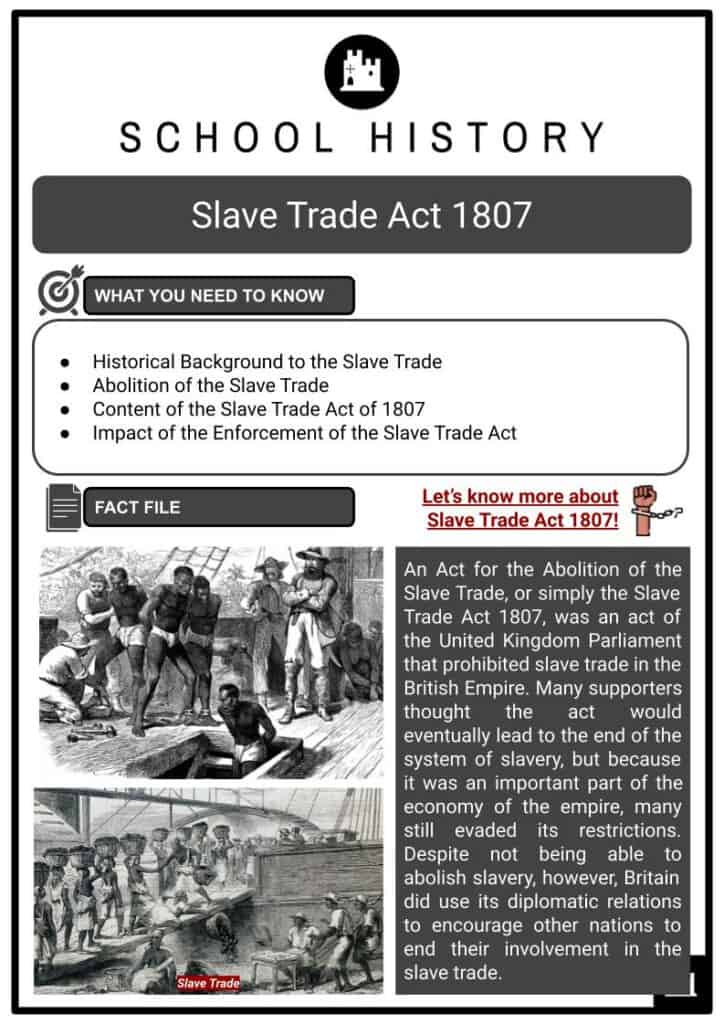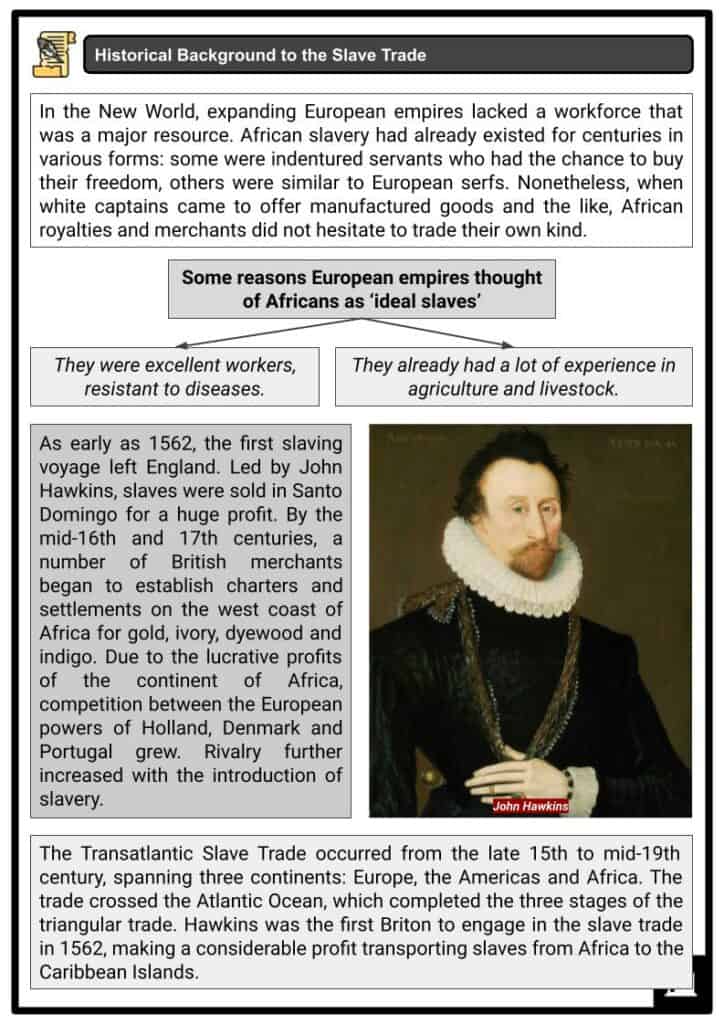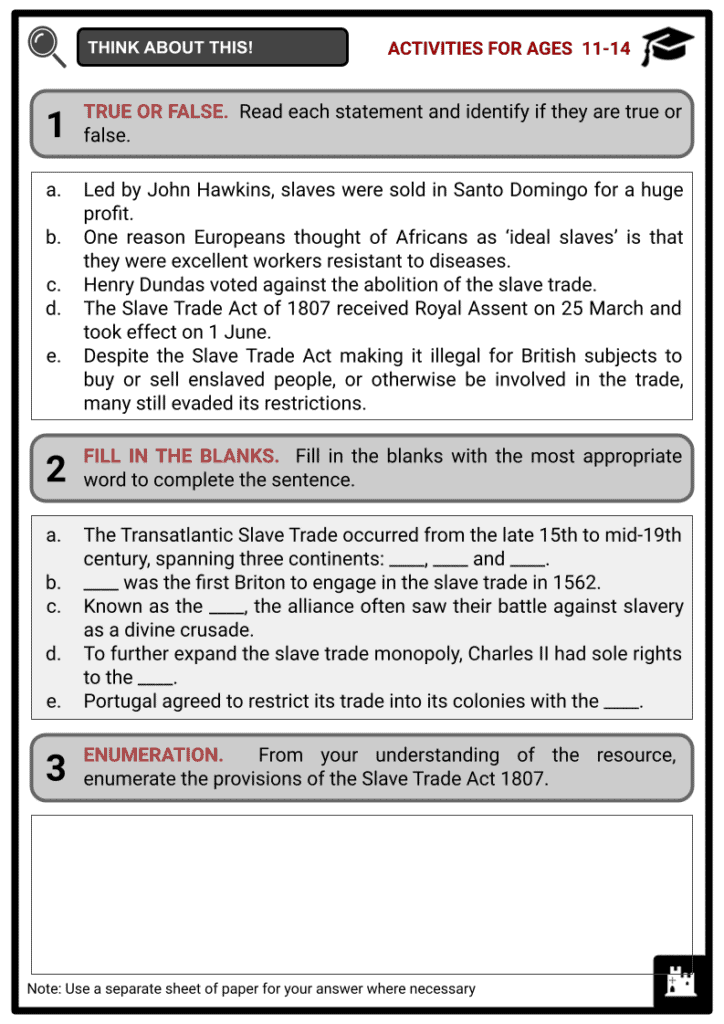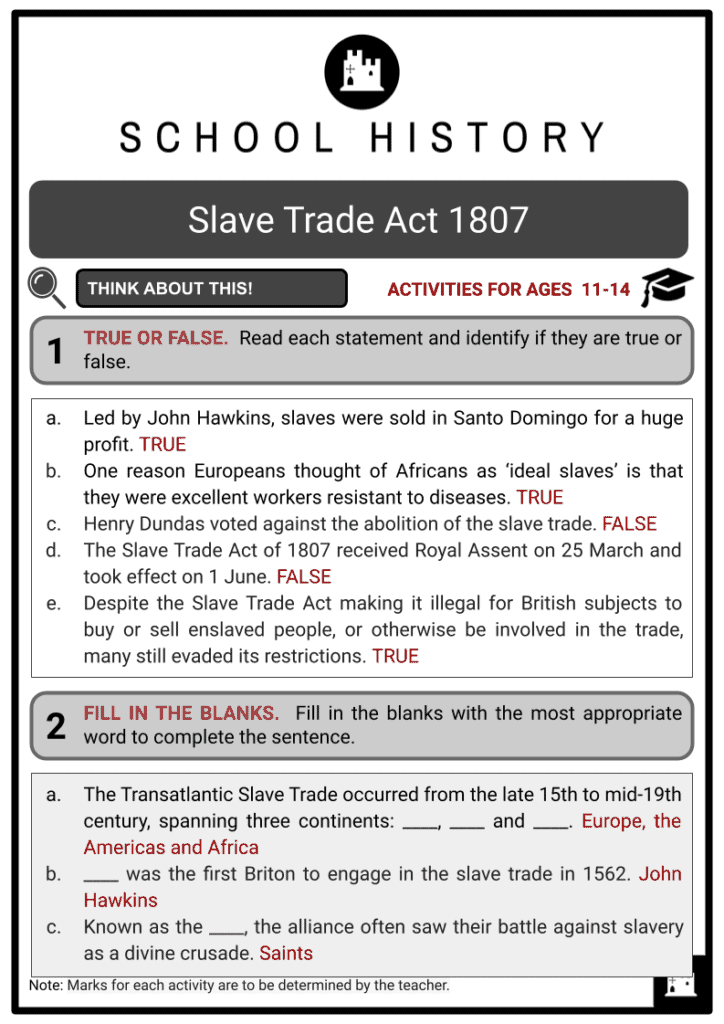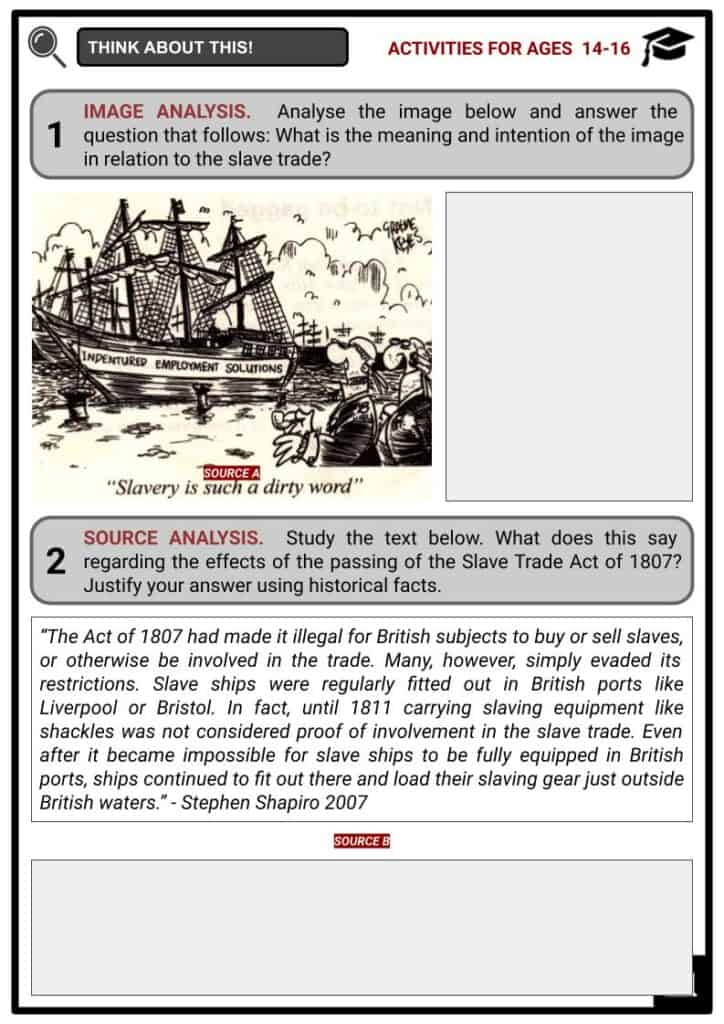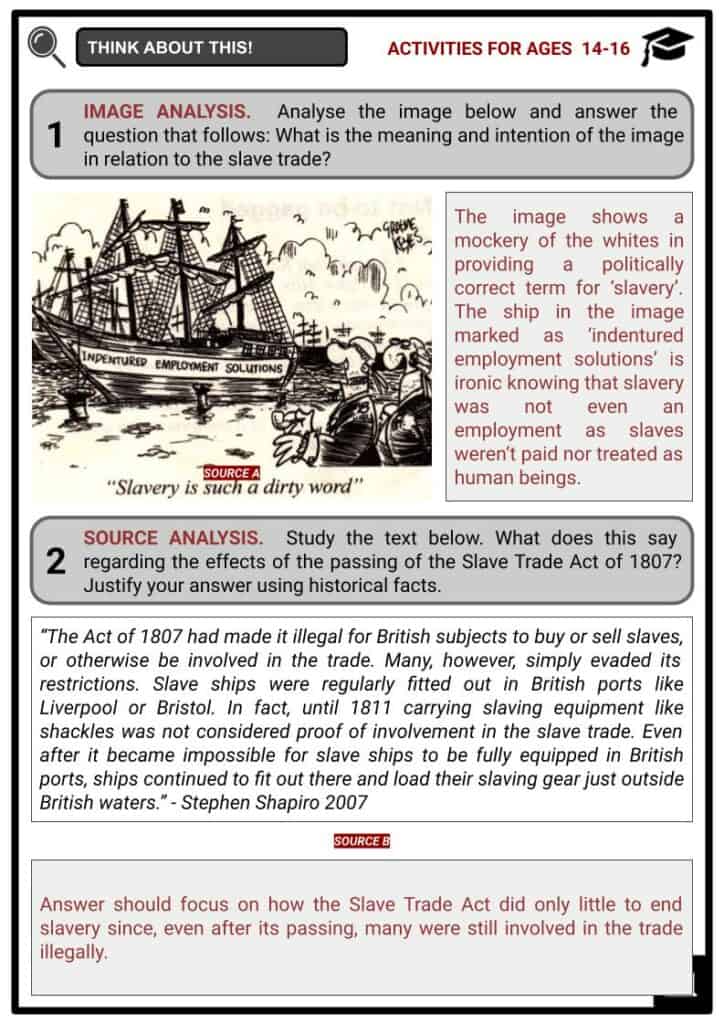Download Slave Trade Act 1807 Worksheets
Do you want to save dozens of hours in time? Get your evenings and weekends back? Be able to teach about the Slave Trade Act 1807 to your students?
Our worksheet bundle includes a fact file and printable worksheets and student activities. Perfect for both the classroom and homeschooling!
Summary
- Historical Background to the Slave Trade
- Abolition of the Slave Trade
- Content of the Slave Trade Act of 1807
- Impact of the Enforcement of the Slave Trade Act
Key Facts And Information
Let’s know more about the Slave Trade Act 1807!
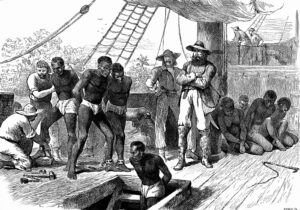
An Act for the Abolition of the Slave Trade, or simply the Slave Trade Act 1807, was an act of the United Kingdom Parliament that prohibited slave trade in the British Empire. Many supporters thought the act would eventually lead to the end of the system of slavery, but because it was an important part of the economy of the empire, many still evaded its restrictions. Despite not being able to abolish slavery, however, Britain did use its diplomatic relations to encourage other nations to end their involvement in the slave trade.
Historical Background to the Slave Trade
- In the New World, expanding European empires lacked a workforce that was a major resource. African slavery had already existed for centuries in various forms: some were indentured servants who had the chance to buy their freedom, others were similar to European serfs. Nonetheless, when white captains came to offer manufactured goods and the like, African royalties and merchants did not hesitate to trade their own kind.
- Some reasons European empires thought of Africans as ‘ideal slaves’
- They were excellent workers, resistant to diseases.
- They already had a lot of experience in agriculture and livestock.
- As early as 1562, the first slaving voyage left England. Led by John Hawkins, enslaved Africans were sold in Santo Domingo for a huge profit. By the mid-16th and 17th centuries, a number of British merchants began to establish charters and settlements on the west coast of Africa for gold, ivory, dyewood and indigo. Due to the lucrative profits of the continent of Africa, competition between the European powers of Holland, Denmark and Portugal grew. Rivalry further increased with the introduction of slavery.
- The Transatlantic Slave Trade occurred from the late 15th to mid-19th century, spanning three continents: Europe, the Americas and Africa. The trade crossed the Atlantic Ocean, which completed the three stages of the triangular trade. Hawkins was the first Briton to engage in the slave trade in 1562, making a considerable profit transporting enslaved people from Africa to the Caribbean Islands.
- The Transatlantic Slave Trade Stages
- In exchange for captured Africans, Europe traded manufactured goods such as clothes, beads and guns to Africa.
- Slave ships from Africa to America were used to transport captured Africans.
- Raw goods like sugar, tobacco and cotton, which were products of slave labour from the plantations in America, were sold to Europe.
-
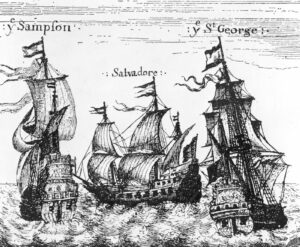
Dutch ships masquerading as Spanish vessels Between 1640 and 1807, the British slave trade dominated the industry. To aid the labour-intensive cultivation of tobacco in the Jamestown colony, about 20 enslaved Africans were purchased from Dutch privateers. As demand for labour intensified, the British crown expanded the slave trade in its colonies in the Americas. Through the Navigation Act of 1660, only English-owned ships were allowed to enter its colonies.
- To further expand the slave trade monopoly, Charles II had sole rights to the Company of Royal Adventurers Trading into Africa, or simply Royal African Company (RAC). Overseen by James, the Duke of York, Britain monopolised the trade of gold, silver and enslaved people from West Africa. In 1750, there were about 235,000 enslaved Africans, of which 85% lived in the south. With the expansion of the slave trade, plantation farming also grew, specifically in South Carolina and Georgia.
Abolition of the Slave Trade
- During the 1700s and 1800s, the slave trade became one of Britain’s most profitable businesses. In that decade, British ships made about 1,300 voyages carrying about half a million enslaved Africans across the Atlantic.
- In 1787, a group of Evangelical English Protestants allied with Quakers united in their shared opposition to the system of slavery and created the Committee for the Abolition of the Slave Trade. By 1807, British abolitionist groups controlled about 40 seats in the British Parliament. Known as the ‘Saints’, the alliance often saw their battle against slavery as a divine crusade.
- The Saints was led by anti-slave campaigner William Wilberforce. On 12 April 1792, Wilberforce sponsored a motion in the House of Commons asking for the slave trade to be abolished. Though he introduced a similar motion in 1791, it was defeated with a vote of 163 opposed and only 88 in favour.
-
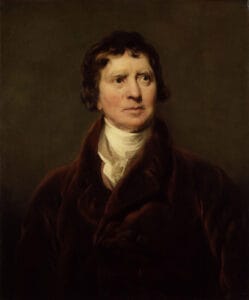
Henry Dundas Henry Dundas, who voted in favour of the abolition of the slave trade, argued, however, that immediate abolition would be ineffective since it would not prevent merchants from other countries to continue the trade abandoned by the British. He then proposed an amendment that would gradually abolish slave trade by moderate measures through Wilberforce’s motion. The amendment was adopted with 192 in favour and 125 opposed. Wilberforce’s motion as amended by Dundas was passed with 230 in favour and 85 opposed.
- Dundas then set out a plan to implement the gradual abolition of slavery by the end of 1799, to which MPs voted in favour of ending it earlier, in 1796. To reflect the new target year, the House of Commons then amended the supporting resolutions tabled by Dundas.
- In January of 1807, the bill was introduced to the Parliament. By 10 February, it went to the House of Commons. Finally, 20 years after Wilberforce began his crusade, on 23 February of the same year, the House agreed to the second reading of the bill to abolish the Transatlantic Slave Trade after winning an overwhelming 283 votes. The bill received Royal Assent on 25 March and took effect on 1 May.
The Slave Trade Act of 1807
- Officially An Act for the Abolition of the Slave Trade, the Slave Trade Act was passed on 25 March 1807 and declared that starting on 1 May of the same year of passing, ‘all manner of dealing and reading in the purchase, sale, barter, or transfer of slaves or of persons intending to be sold, transferred, used, or dealt with as slaves, practiced or carried in, at, or from any part of the coast or countries of Africa shall be abolished, prohibited and declared to be unlawful’.
Main provisions of the act:
- Any ship that were to be found involved in the slave trade would be seized with the ship captain, master, and/or owner liable to be fined £100 per slave. Ships and goods condemned would be forfeited to the Crown. A bounty of £30 for every man and woman and £10 for children under 14 years old was paid to captors of illegal vessels.
- Africans who were ‘freed’, however, were not free to do as they wished for they would be enlisted into the Army or Navy to 'be considered, treated, and dealt with in all respects as if he had voluntarily so enlisted or entered himself'. Those who were not suitable for ‘enlistment’, like women and children, were to become apprentices to land owners, the military, and/or local government, as labourers and domestics.
- In 1808, the Royal Navy established the West Africa Squadron to patrol the coast of West Africa. Between 1808 and 1860, approximately 150,000 Africans were freed and 1,600 slave ships were seized. Moreover, action was also taken against African kingdoms that refused to sign treaties that outlawed the trade. Over 50 African rulers signed anti-slavery treaties as a result.
Impact of the Enforcement of the Slave Trade Act
- Despite the Slave Trade Act not being able to abolish the system of slavery, Britain did use its diplomatic relations to encourage other nations to end their involvement in the slave trade. By the time the transatlantic trade was coming to an end in 1808, only 6 percent of enslaved Africans landing in the New World were going to North America.
- Although the act made it illegal for British subjects to buy or sell slaves, or otherwise be involved in the trade, many still evaded its restrictions. For one, in 1811, carrying slaving equipment was not considered proof of involvement in the slave trade.
How did Britain use its diplomatic relations to encourage other nations to end their involvement in the slave trade?
- Portugal agreed to restrict its trade into its colonies with the Anglo-Portuguese Treaty of 1810.
- The Netherlands outlawed its slave trade in the 1814 Anglo-Dutch treaty.
- Sweden outlawed slave trade through the Anglo-Swedish Treaty of 1813.
- On 2 March 1807, the US adopted its Act Prohibiting Importation of Slaves (although a part of the US Constitution forbade the closing of the slave trade for 20 years, until 1808).
- In the Treaty of Paris of 1814, France agreed to abolish its involvement in the slave trade in five years.
- Spain suppressed its trade by 1820 under the 1817 Anglo-Spanish treaty.
- Those who benefited economically from the slave system found ways to operate under the Spanish or Portuguese flag as both were countries that had not yet outlawed the trade. In addition, beyond British business involvement, government also constantly refused to close the loopholes in its anti-slavery legislation. Parliament too was slow to make slave abolition effective, probably because the slave system was significant for the British economy. With thousands of Africans still enslaved, it took a further 30 years of campaigning before slavery was eventually abolished in most British colonies.
Image Sources
- https://cdn.britannica.com/41/147441-050-AF8ACAF8/captives-African-ships-Slave-Coast-slave-trade-1880.jpg
- https://cdn.britannica.com/41/132141-050-AAC5B4EC/Sampson-ships-Salvadore-Dutch-St-George-Spanish.jpg
- https://upload.wikimedia.org/wikipedia/commons/2/2d/Henry_Dundas%2C_1st_Viscount_Melville_by_Sir_Thomas_Lawrence.jpg

